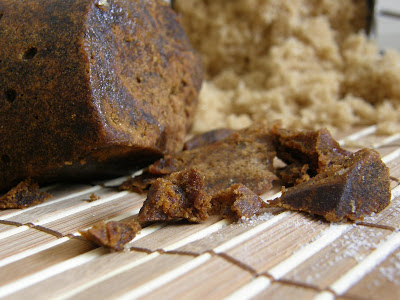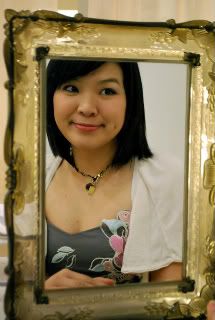To us pastry chef's; it is a marvelous ingredient...an indispensable part of our craft;
....to everyone else; Sugar is Happiness.
 Sugar brings sweetness, which creates joy in our minds and satisfaction in our palates.
Sugar brings sweetness, which creates joy in our minds and satisfaction in our palates...it reminds us of life's pleasantries;
...of lovely childhood memories...
we use it casually in our language to express loving thoughts..
"Sugar, spice and everything nice~"
..We use it as an excuse to say a friendly hello to our neighbour when we drop for a cup of sugar.
You hear the word sung on plenty songs depicting sweet and cherished feelings..
Sugar represents way more than just a staple kitchen ingredient.
Love it or Hate it... its taste, its word and its meaning has made itself a part of worldwide culture and society. I don't see why anyone wouldn't be happy that it has! Well, maybe other than dentists and dietitians at least.

Personally; sweetness really isn't what I'm all about. Both in taste and in personality I must admit. *grin* I'm a little cheeky, a little spicy, and a big big fan of savoury foods! My food cravings often involve starches ...potatoes, crusty breads, salted nuts and the like. Well...chocolate too for the right time of month *wink*. I'll stop there. Hehe.
My fingers dig through at least 10kg's of sugar every week at the NotterSchool, and I've been getting more acquainted to its smell and it's properties. There really is lots more to know about the sugar we eat than just the fine sweet grains we use in our coffee and tea.
Since we've been starting classes on candies and pralines in school; I thought it'd be a good idea to begin with some research to get the ball rolling.
Once a luxury only the extremely affluent could afford, sugar was called "white gold" because it was so scarce and expensive. Although Persia and ancient Arabia were cultivating sugar in the 4th century b.c., the Western World didn't know of it until the 8th century when the Moors conquered the Iberian peninsula. sugarcane (from which sugar is made) was harvested on the shores of the Bay of Bengal; it spread to the surrounding territories of Malaysia, Indonesia, Indochina, and southern China.Ever wondered how is sugar made?:
The Arabic people introduced "sugar" (at that point a sticky paste, semi-crystallized and believed to have medicinal value) to the Western world by bringing both the reed and knowledge for its cultivation to Sicily and then Spain in the eighth and ninth centuries. Later, Venice—importing finished sugar from Alexandria—succeeded in establishing a monopoly over this new spice by the fifteenth century; at that point, it started buying raw sugar, and even sugarcane, and treating it in its own refineries. Venice's monopoly, however, was short-lived. In 1498, Portuguese navigator Vasco da Gama returned from India bringing the sweet flavoring to Portugal. Lisbon started to import and refine raw sugar, and, in the sixteenth century, it became the European sugar capital. It was not long before the sweetener was available in France, where its primary function continued to be medicinal, and during the reign of Louis XIV, sugar could be bought by the ounce at the apothecary. By the 1800s, sugar (though still expensive) was widely available to both upper and middle classes.
Early sugar wasn't the granulated, alabaster substance most of us know today. Instead, it came in the form of large, solid loaves or blocks ranging in color from off-white to light brown. Chunks of this rock-hard substance had to be chiseled off and ground to a powder with a mortar and pestle.
Modern-day sugar is no longer scarce or expensive and comes in myriad forms from many origins. Sugar cane and sugar beets are the sources of most of today's sugar, also known as sucrose (which also comes from maple sap-see maple sugar-and sorghum). Other common forms of sugar are dextrose (grape or corn sugar), fructose (levulose), lactose (milk sugar) and maltosemeringue, (malt sugar). The uses for sugar are countless. Besides its sweetening value, sugar adds tenderness to doughs, stability to mixtures such as beaten egg whites for golden-brown surfaces to baked goods and, in sufficient quantity, it contributes to the preservation of some foods.
(The Food Lovers Companion; Barron + Answers.com-)
- Ripe sugarcane or sugar beets are grown and harvested. They are generally grown in tropical/subtropical regions of the world.
- The canes are then unloaded and cleaned in warm water and the beets are cleaned and cut into stripes
- Juice is extracted with the use to press rollers or crushes to separate the fiber (bagasse) from the juice that contains the sugar.
- The juice is then clarified and about two-thirds of the water is removed through vacumn evaporation.
- Crystallization is the next step in the manufacture of sugar. Crystallization takes place in a single-stage vacuum pan. The syrup is evaporated until saturated with sugar. As soon as the saturation point has been exceeded, small grains of sugar are added to the pan, or "strike." These small grains, called seed, serve as nuclei for the formation of sugar crystals. The growth of the crystals continues until the pan is full.
- The high-speed centrifugal action used to separate the pan of crystals into raw sugar crystals and molasses is done in revolving machines called centrifugals. Once the sugar is centrifuged, it is "cut down" and sent to a granulator for drying.
- Damp sugar crystals are dried by being tumbled through heated air in a granulator. The dry sugar crystals are then sorted by size through vibrating screens and placed into storage bins.
White refined sugar:
Come in various sizes and commonly found as a staple sugar in household kitchens.
- Coarse-grained sugars, such as sanding sugar (nibbed sugar or sugar nibs)
- Normal granulated sugars for table use: typically they have a grain size about 0.5 mm across
- Finer grades result from selectively sieving the granulated sugar
- caster (0.35 mm), commonly used in baking
- superfine sugar, also called baker's sugar, berry sugar, or bar sugar — favored for sweetening drinks or for preparing meringue
 Raw sugars:
Raw sugars:aw sugars comprise yellow to brown sugars made by clarifying the source syrup by boiling and drying with heat, until it becomes a crystalline solid, with minimal chemical processing.Types of raw sugar include demerara, muscovado, and turbinado. Mauritius and Malawi export significant quantities of such specialty sugars. Manufacturers sometimes prepare raw sugar as loaves rather than as a crystalline powder, by pouring sugar and molasses together into molds and allowing the mixture to dry. This results in sugar-cakes or loaves, called jaggery or gur in India, pingbian tang in China, and panela (Columbia), rapadura (Brazil), pile, piloncillo (Mexico) and pão-de-açúcar in various parts of Latin America.
Palm sugar:
Is originally made from the sugary sap of the Palmyra palm or the date palm. Now it is also made from the sap of the sago and coconut palms and may be sold as "coconut sugar." The sugar is a golden brown paste, sold in tubes, blocks or tin cans. It may be light-colored or dark, soft and gooey or hard. Gula melaka is used in some savoury dishes but mainly in the local desserts and cakes of the Southeast Asian region.
In Indonesia, sugar made from the Palmyra palm is known as Gula Jawa ("Javanese sugar") or gula merah (red sugar).
Brown sugar:
Brown sugar comes from the late stages of sugar refining, when sugar forms fine crystals with significant molasses-content, or from coating white refined sugar with a cane molasses syrup. Their color and taste become stronger with increasing molasses-content, as do their moisture-retaining properties.
- Dark and light muxcovado sugar : known as the Barbados sugar or moist sugar, It is rich and spicy with a high molasses content and more minerals than other sugars
- Demerara sugar: Is a tan and coarse sugar, partially refined sugar. Originally named for the old colony of Demerara in the South American country of Guyana. It is now primarily produced in Mauritius.
- Turbinado: a partially refined cane sugar which is processed with steam and has a pleasant vegetal flavour.
Isomalt: A natural sugar substitute, a type of sugar alcohol, which is primarily used for its sugar-like physical properties. It has only a small impact on blood sugar levels, does not promote tooth decay, and has one half the calories of sugar. However, like most sugar alcohols, it carries a very real risk of gastric distress, including flatulence and diarrhea, when consumed in large quantities. Isomalt is typically blended with a high intensity sweetener such as sucralose, so that the mixture has approximately the sweetness of sugar. Isomalt has been approved for use in the United States since 1990. It is also permitted for use in Australia and New Zealand.
Isomalt is usually used in sugar sculptures and is preferred by some because it will not crystalize as quickly.
Now that we know much more about Sugar and the stories behind its sweetness (more than necessary really); do you think we're all ready for the next 2 weeks of class with Chef Ewald Notter and his skillful ways with sugar?

 My clumsy self is shuddering at the thought of boiling numerous pots of bubbling sweets! *laughs* Burns will probably be unavoidable; Can't learn to ride a bike without scraping a knee or two, no? Hehe.. I'm ready! The enthusiasm is definitely going to help numb the pain. *giggle*
My clumsy self is shuddering at the thought of boiling numerous pots of bubbling sweets! *laughs* Burns will probably be unavoidable; Can't learn to ride a bike without scraping a knee or two, no? Hehe.. I'm ready! The enthusiasm is definitely going to help numb the pain. *giggle*










9 comments:
thanks for the yummilicious chocolates! :)
Ooooh, I'm a huge lover of the sugar food group ;-) I'll be following this part of your NotterSchool journey very closely!!
How could you forget gula melaka ;P
Wow, Su, you are such an inspiration!
i agree what you said burn cant be avoid when playing sugar, but still i wanna advice that its important for beginer to wear glove when dealing with ht sugar mas , im sure no 1 would want to have a scar on their hands and i ve been through that , its
really painful and i had a scar on my hand by caramelize sugar. but hope u
had a good time learning with chef notter .
I love reading your posts about...delicious things.
Um. I realize I'm much older than you and you might not agree...but Chef Ewald Notter is HOT. I don't think I'd be able to concentrate with him as my teacher.
kas: hehe love you too~
em: More sugar coming up dear! Chocolates and pralines were just the beginning, we have a sweet journey ahead
the evil lemon: thanks for that! haha ;)
anonymous: thanks! :)
breadpitt: sugar can get a little painful from the heat; but im kinda used to it now, I have fairly thick skin on my fingers haha, high tolerance to pain too/ I dont think the gloves help at all with the heat
sisterlibby: thanks sister :) looking forward to hearing from you soon
heather: he is delicious looking isnt he? haha Im so lucky to have handsome chefs around me all day! haha, it really doesnt get any better :P
Thank you for posting all the differences about sugar! How interesting! (and so were the images!) :o)
Cindy H
http://www.jbkpottery.com
Post a Comment